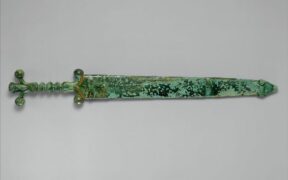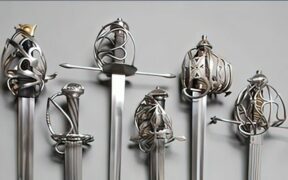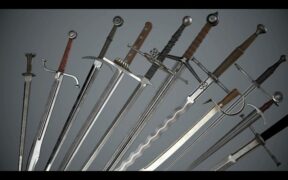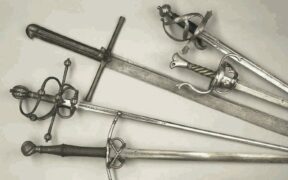Our content features commercial links to our products, committed to transparent, unbiased, and informed editorial recommendations. Learn More
Irish Sword Types: Their History and Use in Warfare
NO AI USED This Article has been written and edited by our team with no help of the AI
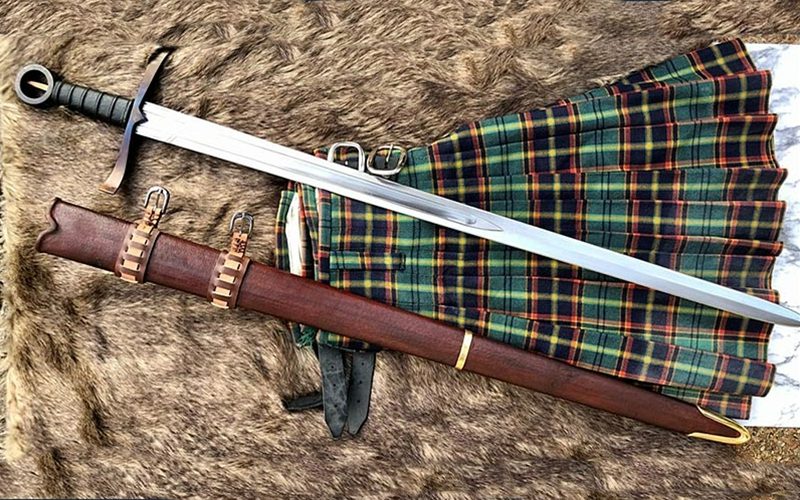
Most recognized for its open ring pommel, the Irish sword served as an efficient slashing weapon against chain mail, a form of body armor that remained in use in Ireland even though it was obsolete elsewhere in Europe. Various invaders from different periods also played a role in shaping Irish swords and warfare.
Let’s explore the history and characteristics of Irish swords and how they differ from the Scottish claymore and other medieval swords.
Types of Irish Swords
Irish swords may be classified into three groups. While Group 1 consists of a sword type common throughout Europe from the 12th to the early 14th centuries, Group 2 includes swords that probably evolved in Scotland and were introduced into Ireland by Scottish mercenaries. On the other hand, Group 3 features 16th-century Irish swords with distinctive ring pommels.
Group 1
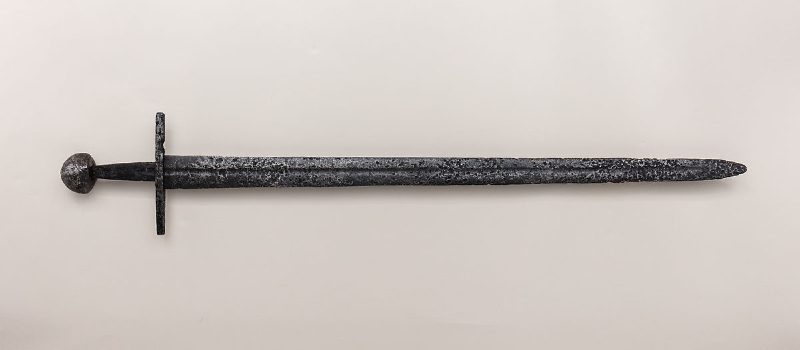
The beginning of the medieval Irish sword is somewhat vague, as the knightly sword, also called the arming sword, was the standard form throughout medieval Europe. Some suggest that knightly swords appeared in Ireland due to the presence of Anglo-Norman knights after 1170. However, some were already known in the region, even before the Anglo-Norman invasion, and may even be from the 11th-century.
Knightly swords were single-handed and had simple, straight crossguards. Irish examples had long, broad, and double-edged blades. Most were suitable for cutting blows and efficient against chain mail. Some had brazil-nut pommel with convex upper and lower edges, while others had wheel pommels.
These knightly swords evolved from the Viking swords used in Ireland up to the 12th century. Some were similar to the sword types used by the Anglo-Normans in Ireland during the 13th to early 14th centuries. The Irish likely used them when they were beginning to adopt the arms and armor of the Anglo-Normans. Also, these swords are indistinguishable from those used in Britain and other parts of Europe.
Group 2
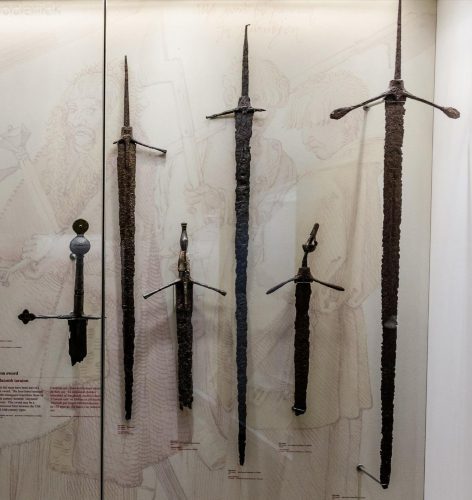
Group 2 is a Scottish or Hiberno-Scottish type sword, showing the relations between late medieval Ireland and Highland Scotland. They seem to have developed in Scotland from earlier medieval swords, and then the Scottish mercenaries, the gallowglass, introduced them into Ireland and was later used by the Irish during the 15th century. However, they ceased to be used after about 1350 in western Europe.
The Gaelic and Scottish type has a distinctive crossguard, usually long, downward-sloping arms. Some also have triangular quillon terminals instead of sloping downwards while others feature plain, quatrefoil, or expanded terminals. These swords also feature pointed langets or strips of metal extending down the blade and tend to have hollow pommels derived from the wheel-pommel form.
Most of these swords correspond to Oakeshott’s types XIII/XIIIA or XIX, and some of them are hand-and-a-half swords which can be more than single-handed, but less than a two-handed sword. Some historians consider those with quatrefoil quillon terminals as the earliest form of West Highland Claymore sword as they featured bar quillons instead of the cone-shaped quillons of the 16th-century Scottish claymores.
However, some historians have argued that such swords should not be referred to as claymores as the term should be confined to the true claymore of the 16th century. The Group 2 swords in general, were likely manufactured in Scotland and Ireland because their cross guards and pommels are unique to the respective regions.
Group 3
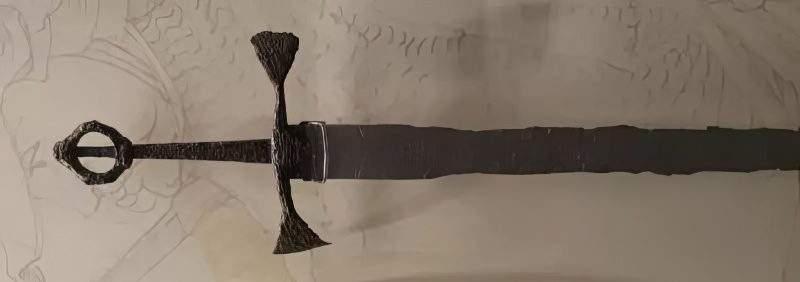
Group 3 was the sword type used in Ireland in the late 16th century and seems unique to the country. These Irish swords featured an open ring pommel which likely developed from the medieval wheel pommel — a flat circular pommel that replaced the earlier spherical and other types in the 14th century and became the most popular type by the 15th century. These swords served as a weapon of the Gaelic Irish, though only a few of this type have survived.
Characteristics of Irish Sword
The Irish used various swords throughout the medieval and Renaissance periods, though Irish swords often imply the 16th-century swords with a ring pommel.
Here are the characteristics of the Irish sword:
Metal and Construction
The Irish sword blades were likely Continental imports as similar blades appeared on 16th-century German swords. Some featured a cross pommée mark and some historians consider it a German mark imitating an Italian one. Surviving examples have good quality steel and the crossguard and pommel have the same quality metal as the blade.
Irish swords had hilts manufactured in Ireland and equipped with imported blades. Modern replicas are sometimes hand forged and feature high carbon steel blades, though damascus steel is rare. Decorative swords may also have stainless steel blades.
Blade Appearance
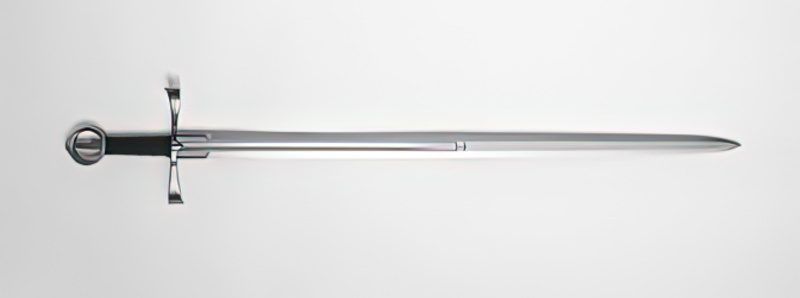
Irish swords had long, slender, double-edged blades. Most featured a ricasso or blunt-edged portion of the blade above the sword guard. Some lacked a fuller, though others had narrow grooves extending down the blade with similar grooves at the edges of the ricasso. Some historical examples featured a heraldic cross pommée inlaid on one side of the blade.
Size and Length
Some surviving examples have an overall length of more than 100 centimeters (39 inches) with a blade length of about 90 centimeters (35 inches). Their slender blades often measure about 2.8 to 3.6 centimeters, and their ricasso about 5.6 to 9.2 cm long. Most have lightweight hilts and heavy blades, pushing the point of balance down the blade, suggesting that they served as slashing weapons.
Sword Mounting
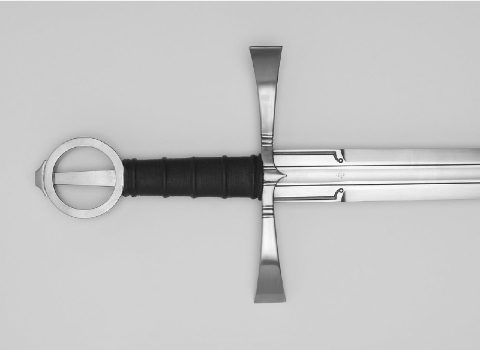
Surviving examples of Irish swords generally have single-handed grips, originally covered with wood and probably ribbed and bound with wire. Some feature an elongated S-shape crossguard with quillons curling in opposite directions. Some have quillons ending in long fan-shaped or triangular terminals. Some quillon terminals also feature openwork crosses cut out near the ends. Two langets also extend on the blade from the crossguard.
Irish swords are most recognized for their open ring pommel, about 3.8 to 5.6 centimeters in diameter through which the tang passes. Many collectors describe battle-ready sword as full tang blades, though historical and modern reproductions of Irish swords tend to have tapered tangs covered at the top by a small cap. These swords probably had wooden scabbards covered with leather or textile and had a thick fringe at the chape ends.
Some accounts also mention a two-handed variant of an Irish sword—or perhaps a longsword with a long grip to accommodate two hands. However, some pictorial depictions of Irish swords are inaccurate. The famous 1521 painting War Men of Ireland by Albrecht Dürer portrays Irish warriors carrying an exaggerated size of Irish sword.
Irish Sword vs. Scottish Claymore

The Highland claymore is a two-handed sword used by the Scottish Highlanders around the 15th to the early 17th century. The name claymore comes from the Scottish Gaelic claidheamh mór, meaning great sword. Unlike its prototype, the Highland claymore has a crossguard angling toward the blade, with quatrefoils at the end of quillons.
On the other hand, the 16th-century Irish swords are most distinguished for their open ring pommel and surviving examples often have single-handed grips. Both swords have straight and double-edged blades, but the Scottish sword is significantly longer. As a two-hander and a greatsword, the Highland claymore has an overall length ranging from 120 to 138 centimeters (47.2 to 54.3 inches), while surviving Irish swords are often only over 100 centimeters (39.4 inches) long .
Swords in Celtic and Irish Mythology
The Celts were Ireland’s most significant ancient settlers during the Iron Age, beginning around 500 BCE. Swords had religious significance to the Celts and were immortalized in Celtic myths. In Celtic tradition, the weapons of gods, kings, and heroes had supernatural powers and had names.
The most famous Irish mythological sword is perhaps the Caladbolg, a lightning sword owned by several heroes. One of them is the Irish hero Fergus mac Róich, who used the Caladbolg to cut off the tops of three hills in County Meath, Ireland. Some even associate the Irish Caladbolg with King Arthur’s magical Excalibur, as its Welsh name Caledfwlch is phonetically similar to the other.
History of Irish Swords
One of the Irish words for sword is claidheamh, old Irish claidem. The other term is colc or colg, which implies a dirk or a small straight-bladed sword. Some also suggest that colg originally referred to the small Iron Age thrusting swords. On the other hand, the claidem, sometimes spelled claideb, denoted longer swords designed for cutting or slashing from the 5th century onwards.
The Irish swords and other weapons were greatly influenced by invading cultures, though there was a lack of dramatic changes in military technology through the late Middle Ages.
In the Early Medieval Period (400 – 800)
Early medieval Ireland was not highly militarized. Many Irish weapons were inferior in quality, while some were efficient. The typical weapons of an Irish warrior consisted of a sword, a shield, and spears which were ideal during the Iron Age and throughout the early medieval period.
In Celtic Ireland, Irish swords were both single-edged and double-edged, and the latter likely developed from Roman swords—the short sword gladius and the long sword spatha which themselves were derived from Iron Age swords.
On the other hand, the Irish single-edged sword was the Germanic scramasax type, though it was distinctive. Generally, the Irish single-edged swords were lighter and smaller than similar weapons found in the Anglo-Saxon world.
In Viking/Hiberno-Norse Period (800 – 1170)
The Irish weapons and warfare transformed during the Viking Age from the 9th to the 11th century. The term Hiberno-Norse refers to the civilization of the inhabitants of the Viking towns in the 11th and 12th centuries. While the Vikings never succeeded in conquering Ireland, they established several bases along the Irish coastlines and fought and allied with native Irish kings.
The Viking Age introduced finer and more expensive swords, though the Irish adopted the cheaper battle ax. However, the Irish did not wear armor in the battle and their clothing did not differ significantly from the civilian dress, unlike the Vikings equipped with a hauberk. They could have obtained Viking armor through combat or trade, though the adoption of armor did not happen to the same extent as it did with weapons.
In the Anglo-Norman Period (1170 – 1300)
The Anglo-Norman world emerged when William, duke of Normandy, conquered England in 1066. The Anglo-Norman invasion of Ireland began in 1169. The tactics and organization of these invaders led to their success rather than their weaponry and technology.
The invading medieval knights used spears and swords suited for cutting blows when fighting on foot or on horseback. The Irish swords from the 12th to the 14th century were typical swords the Anglo-Normans would use. The conquest also resulted in the Irish use of armor by the 13th century.
Late Medieval Period (1300-1550)
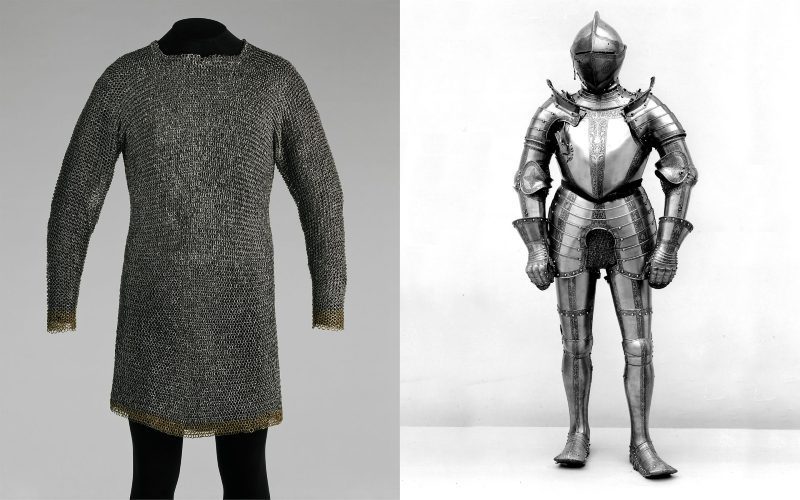
By the 13th century, plate armor became common in Europe, so sword blades also became sharply tapered, suited for thrusting in the gaps of the armor. However, the late medieval Irish swords retained the blade forms designed against mail armor. The Irish continued to use the chain mail which was obsolete elsewhere in Europe during that time. Meanwhile, swords designed for cutting or slashing remained efficient in Ireland.
Even in 12th-century Ireland, the physical environment and warfare tactics required mobility which probably discouraged strong and heavy armor. The warfare tactics also consisted of raiding rather than large-scale battles or campaigns. The Anglo-Irish archers also used swords and bucklers, though the poorest commoners fought with staff weapons like glaives.
The Gallowglass and their Weapons
Also spelled galloglass, the gallowglass were Scottish mercenaries who fought in groups of Irish chiefs and warlords from the 13th to early 17th centuries. The term comes from the Gaelic galloglaigh, meaning foreign warriors. They originated from Argyll and the Western Isles of Scotland.
The gallowglass formed the elite force of Irish chiefs during wartime and served as their bodyguards in peacetime. The Scottish gallowglass also expanded their influence by recruiting local Irishmen. So, the term eventually refers to a type of warrior rather than being associated with specific ethnic origin.
Their fighting style involved using weapons that could deliver powerful slashing blows to their enemies. Most relied on axes derived from those of the Vikings, though others utilized spears. In fact, mastering the heavy, two-handed ax was part of training for every new gallowglass recruit.
Some gallowglass used two-handed swords made in Ireland, though they were never a common weapon. Also, they were considered ax men by their contemporaries. They also carried sidearms, from a dirk to a single-handed broadsword (claidem).
Irish Swords in Modern Times
Like the crusader and Templar swords, Irish swords can be seen in historical re-enactments and live-action role-playing or LARP. Sword collectors also prized them for their distinctive Irish design and modern reproductions feature various types ranging from single-handed to hand-and-a-half and longswords. Several replicas are also functional swords with sharp blades and are suitable for backyard cutting practice against targets like tatami mats and water-filled bottles.
Conclusion
Throughout history, the sword served as the ideal weapon of a warrior. Early medieval Irish swords were the knightly swords widespread throughout the Middle Ages in Europe, but later developed into the open ring pommel type unique to Ireland. Today, Irish swords remain relevant among collectors, re-enactors, and LARPers.
